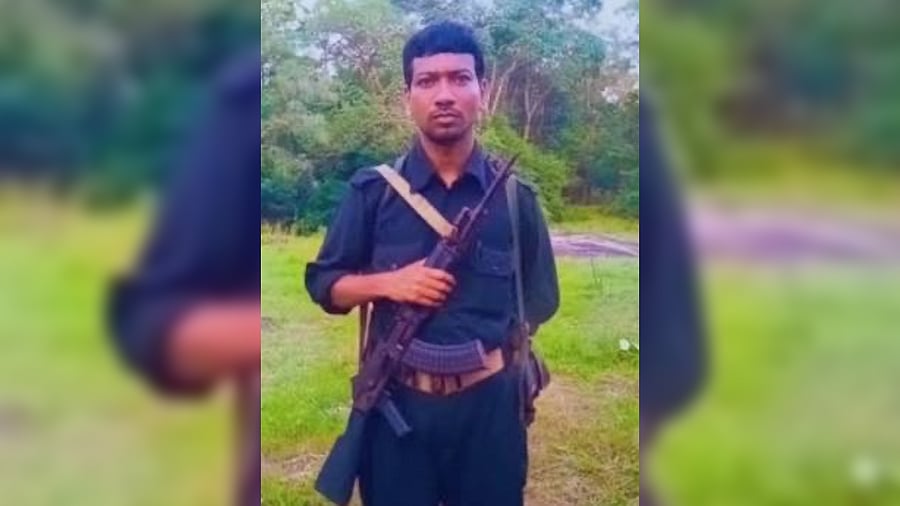
Madvi Hidma.
Credit: Special Arrangement
Known for his mastery in guerrilla warfare, Madvi Hidma, who was neutralised by security forces on Tuesday, had long been one of the most feared and tactically astute leaders of the outlawed CPI (Maoist). Over the years, he rose from an impoverished tribal youth in Bastar to the commander of Battalion 1 of the People’s Liberation Guerrilla Army (PLGA), one of the Maoists’ most lethal and well-trained combat units.
His elimination marks a significant blow to the Maoist movement, depriving it of a leader who provided critical direction to its combat wing.
The 55 year old leader had narrowly escaped capture in January this year during a massive anti-Naxal operation in south Bastar’s Pujari-Kanker area, where 18 Naxalites were killed.
Operating mainly across the Sukma, Dantewada, and Bijapur districts of Chhattisgarh, Hidma’s battalion was known for its firepower and discipline. Around 80 percent of its fighters carried automatic or semi-automatic rifles—AK-series weapons, self-loading rifles, and light machine guns—making it a formidable force in the jungles of Bastar.
Such was his importance that Hidma operated under a three-tier security ring. Apart from leading PLGA’s Battalion 1, he was a member of the Dandakaranya Special Zonal Committee and one of the youngest inducted into the CPI (Maoist) Central Committee. Born in Puvarti, a small village in Sukma district, Hidma—also known as Hidmallu and Santosh—belonged to the Muriya tribal community. Locals estimate that nearly half of Puvarti’s 100-odd households have at least one family member associated with the Maoists.
Before joining the armed movement around 1996–97, Hidma worked as a farmer. His humble background and tribal identity helped him connect deeply with Bastar’s local communities, from whom the Maoists draw most of their recruits. “Being a tribal himself, and coming from central India’s jungle belt, Hidma had a natural rapport with the cadres,” said a senior intelligence officer involved in anti-Naxal operations. “Most of the foot soldiers are tribal from similar backgrounds. That connect helped Hidma emerge as one of the most popular military commanders among them. He was among the very few tribals to hold a top leadership role as most senior Maoist leaders traditionally came from the plains,” the senior officer told DH.
Quiet and intensely focused, Hidma was known to be curious and eager to learn. Through a college lecturer who worked with the Maoists, he learned basic English and Hindi languages foreign to his Gondi-speaking roots. Though he studied only till Class 7, his intelligence and grasp of tactics stood out. By 2000, he was assigned to the Maoist weapons manufacturing unit, overseeing local production and repair of firearms, grenades, and rocket launchers.
Between 2001 and 2007, he served as a regular member of the PLGA’s South Bastar platoon. The rise of the Salwa Judum movement during this period, an anti-Maoist vigilante campaign supported by the state radicalised him further. Widespread alleged human rights violations during Salwa Judum triggered resentment among tribals, a sentiment that the Maoists exploited to rebuild their strength. For Hidma, this backlash transformed him from a committed foot soldier into one of the movement’s most battle-hardened leaders.
Unlike many senior Maoists who were either eliminated or surrendered, Hidma managed to evade capture for decades. His deep knowledge of terrain, local dialects, and dense social networks gave him a near-mythic advantage in the forested tracts of Bastar. Among local youth, he was regarded with near-godlike reverence, seen not merely as a militant, but as a tribal son standing up to state power.
With Hidma’s killing, security forces have eliminated a crucial link between the Maoist top brass and its ground-level cadres.
Notable attacks & activities of Hidma:
2010 Dantewada Attack: An ambush that resulted in the deaths of 76 CRPF personnel.
2013 Jhiram Ghati Massacre: An attack on a convoy of Congress leaders in Chhattisgarh, leading to 27 fatalities, including senior political figures.
2017 Burkapal Ambush: An assault that killed 25 CRPF personnel.
2021 Sukma-Bijapur Attack: A well-planned ambush involving over 400 Maoist fighters, resulting in the deaths of 22 security personnel and injuries to several others.